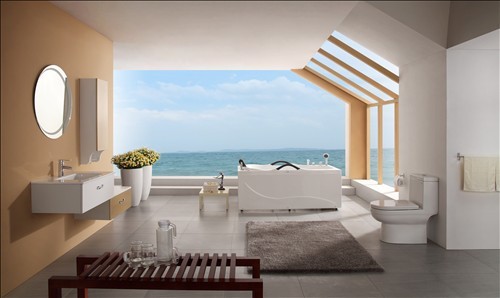
When it comes to modern bathroom renovation, purchasing ceramic products is almost unavoidable. However, many consumers lack the fundamental knowledge about ceramics and often rely solely on appearance and price when making a decision. This can lead to serious issues such as poor cleanliness, weak odor control, cracking of ceramic parts, surface discoloration, and even health risks over time.
Understanding key technical terms and specifications is essential to ensure you choose high-quality ceramic products that are durable, easy to clean, and safe for your home.
Water Seal
â—† Water Seal Height: The vertical distance from the water surface in the trap to the highest point of the waterway entrance should be at least 50mm for all toilets, urinals, and squatting fixtures with integral traps.
â—† Water Seal Area: The surface area of the installed toilet water seal on the horizontal plane should not be less than 100mm x 85mm.
â—† Water Seal Function: It isolates odors, maintains sufficient pressure to assist in flushing, helps dilute waste, and prevents dirt from sticking.
Drainage Distance
â—† Toilet drainage methods typically include lower drainage, horizontal drainage, rear drainage, and wall-mounted drainage. Each method has its own installation requirements and performance characteristics.
Water Absorption
â—† Water absorption refers to the percentage of weight increase of a ceramic product after being soaked in water for a certain period at a specific temperature.
â—† The higher the firing temperature, the lower the water absorption rate.
â—† A lower water absorption rate means the ceramic is less likely to absorb stains and easier to clean.
â—† Lower water absorption also means less moisture retention, which is better for hygiene and user health.
Burning Temperature
â—† This is the maximum temperature at which ceramic reaches the required quality standards after high-temperature firing.
◆ For four-dimensional ceramic sanitary products, the firing temperature can reach up to 1280°C. This ensures high strength, reduces the risk of cracking over time, and results in low water absorption, promoting better health and hygiene.
Dilution Rate
â—† Dilution rate measures the product's ability to replace wastewater effectively.
â—† If the dilution rate is below standard, the flushing performance may be poor, leading to incomplete cleaning and unsanitary conditions.
Flushing Method
â—† Siphonic Toilet:
This type of toilet uses negative siphon pressure created by water flow in the drain pipe to suction waste out of the bowl. The design of the drainage pipe is critical—smaller diameters are more efficient for siphoning but can lead to clogs, while larger diameters may reduce siphon effectiveness. Siphonic toilets require strong water pressure and velocity during use.
With the development of large-diameter technology by companies like Gemmers, siphonic toilets have become popular in the domestic market, featuring a 51mm pipe diameter that provides excellent flushing performance.
â—† Direct Flush Toilet:
This method relies on concentrated water pressure to flush waste out of the bowl. It requires a drainage pipe diameter of more than 70mm, which makes it less prone to clogging. The main advantage of this design is its large drainage capacity and reliability in daily use.
Round Ceiling Light,Circular Ceiling Light,Circular Led Ceiling Light,Round Ceiling Lamp
Ningbo Royalux Lighting Co., Ltd. , https://www.royaluxlite.com
